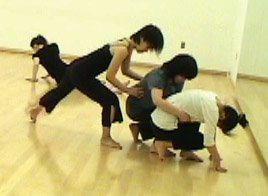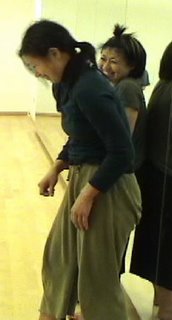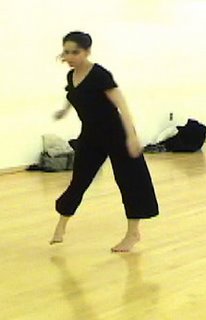Monday, November 19, 2007
I'm not the only one
A really important part is his description of the butt/pelvic floor relationship: the more the butt grips, the harder it is for the pelvic floor to engage. This seems only logical since the gluteus maximus is much larger than the pelvic floor muscles. But we need the pelvic floor for, like, staying continent, keeping organs from prolapse, being in synergy with deep abdominal and spinal muscles,...kind of important stuff.
Another issue is that, since the butt is a hip extensor, grip there is going to lock the pelvis and leg into extension, and it's not going to want to move. When it is supposed to, for walking or sitting down let alone dancing or anything else, other joints are likely going to end up moving more to make up for the places that are stuck. And especially if those joints are moving beyond their range of motion, those are the places likely to get injured. The joints closest to the hip are likely to be most affected: the SI (sacroiliac) joints and lower back above, knees to feet below.
Walking with buttgrip, at the extreme, gets toward that just-got-off-the horse waddle or shuffle. Sitting is likely to be rolled back off the sitzbones and slumped in the lower spine. I once saw a woman attempting to take a seat on a crosstown bus; her hips would not bend, so she ended up doing a hinge to drop her upper back against the seat and just barely caught her bottom on the front edge of the seat--one bump of the bus and she could have slid off the seat onto the floor.
The butt is a powerful muscle set, great for climbing, big jumps, getting up and down from the floor. Wasting that power on holding yourself up is likely to leave the muscles too tight to do those things.
Jonathan FitzGordon has an e-newsletter (subscribe and find other cool information at fitzgordonmethod.com), which most recently included the Relax Your Butt post and also this Exercise of the Month:
We overwork our butt. Before you learn to let it go you have to realize how much you grip it. Spend the next few days checking in with your glutes to see how often they are relaxed, if ever. Specifically watch what happen when stress enters the picture.
PS Been away from the blog too long. Return is more likely to be monthly than weekly or daily. But I'll be back.
Friday, March 23, 2007
Been a While
follow the bouncing bot
Wednesday, April 19, 2006
Concert Announcement: Peripheral Dances

We open in a little over a week!

Peripheral Dances
Featuring works by Gail Accardi, Sue Bernhard, Laurie De Vito, Mami Fujita & Maki Hatae, and Akiko Tomikawa & Rie Hozumi. Dance film by Kristina Jones
Dancers: Gail Accardi, Rachel Feinerman, Mami Fujita, Maki Hatae, Rie Hozumi, Sally Im, Yuko Meads, Hae Young Oh, Megumi Onishi, Nicole Speletic, Akiko Tomikawa, and Alissa Wall
Sundays April 30, May 7, and May 14 at 7:30pm at the
Green Space Studio Theater
37-24 24th Street

Long Island City, NY
Tickets $10
gailaccardi@earthlink.net for reservations and information
More pictures here.

Friday, April 14, 2006
I was born that way
"The DNA of Dancing" THE WEEK, March 10, 2006
Some people, it appears, are born to dance. After analyzing the DNA of the families of 85 professional dancers and 872 other people, researchers spotted two genes that appeared in the dancers, but not in others. They weren't genes for rhythm, coordination, or flexibility. Instead people who love to dance are genetically programmed to respond strongly to hormones and chemicals that promote feelings of spirituality, social communication, and bonding with other people.
"The genes we studied are more related to the emotional side of dancing," researcher Richard Ebstein tells Discovery.com. Dancers, he said, have "the need and ability to communicate with other people and a spiritual side to their natures that not only enable them to feel the music but to communicate that feelings to others via dance."
I was unable to find this particular article online, but did find the Discovery Channel tidbit and--joy to geeks everywhere--the study report. Some highlights and clarifications:
We suggest the notion that the “dance” phenotype is no more difficult to define than other complex human behavioral phenotypes (schizophrenia, attention deficit, personality, violence, and others) that have been shown to be both heritable and amenable to genetic analysis. Dancers fulfill a set of criteria with considerable face validity (similar in principle to the usual Diagnostic and Statistical Manual of Mental Disorders–style “symptom checklist” [12]) that both identifies and distinguishes one disorder from another. For example, the US Department of Labor suggests that the following qualities, inter alia, are required to be a professional dancer: flexibility, agility, coordination, grace, a sense of rhythm, a feeling for music, and a creative ability to express oneself through movement [13].
I of course can't help but be charmed by the grouping of dance with schizophrenia et al and the implication we've a DSM-worthy disorder.
The study looks at two polymorphic genes and notes a preponderance of certain interdependent variations in dancers vs. athletes and also nondancers. These genes have implications correlated with two scales of human personality traits. One is the Tellegen Absorption Scale, which the study cites in reference to its association with spirituality, on the theory that sacred dance rituals have existed across cultures. To me, that sort of aggrandizement seemed unnecessary--the questions reflected, simply, absorption, the ability to lose oneself in the moment. As in that dancer high we all chase, no higher purpose needed. High scores on the scale are also linked to hypnotizability.
The other is the Tridimensional Personality Questionnaire (can't find it online), specifically its Reward Dependence dimension. (Questionnaire description found here):
Tridimensional Personality Questionnaire
The TPQ is a 100-item, self-administered, paper-and-pencil, true/false instrument which takes approximately 15 minutes to complete (Cloninger, 1987a). The questionnaire measures the three higher order personality dimensions of novelty seeking, harm avoidance, and reward dependence, each of which measures four lower order dimensions (Cloninger, 1987b). The novelty seeking domain measures the spectrums of exploratory excitability versus stoic rigidity (9 items), impulsiveness versus reflection (8 items), extravagance versus reserve (7 items), and disorderliness versus regimentation (10 items). The harm avoidance domain measures the spectrums of anticipatory worry versus uninhibited optimism (10 items), fear of uncertainty versus confidence (7 items), shyness with strangers versus gregariousness (7 items), and fatigability and asthenia versus vigor (10 items). The reward dependence domain measures the spectrums of sentimentality versus insensitiveness (5 items), persistence versus irresoluteness (9 items), attachment versus detachment (11 items), and dependence versus independence (5 items). The TPQ is based on a unified biosocial model of personality integrating concepts focused on the neuroanatomical and neurophysiological basis of behavioral tendencies, styles of learning, and the adaptive interaction of the three personality dimensions (Cloninger et al., 1991).
Interestingly, the Village Voice article cited in the previous post mentions
the understanding that choreographers and dance critics have something in common besides a love for the form; we are, as [Tere O'Connor] puts it, "two populations with reward deficit."
Make of that what you will. The dancers scored higher than athletes and nondancers on reward dependence, which the study links with interpersonal communications. On that basis, if we regard dance as a form of communication, it makes some sense, though I'd still like to see the questions to understand where the difference is between competitive (thus, presumably reward-seeking) athletes vs. performing dancers. The study's description of the reward dependent
Individuals high in TPQ Reward Dependence tend to be tender-hearted, loving and warm, sensitive, dedicated, dependent, and sociable [58]. They seek social contact and are open to communication with other people. Typically, they find people they like everywhere they go and are sensitive to social cues, which facilitates warm social relations and understanding of others' feelings. The observed association between TPQ Reward Dependence scores and AVPR1a is consistent with the role of the arginine vasopressin receptor in social communication as demonstrated in extensive animal experiments [59]. The association between AVPR1a and Reward Dependence personality traits strengthens the notion that this gene contributes to dancing through its contribution to social communication.
seems to reflect cultural differences between dance and sport environments, but I've tended to stay away from the more cutthroat competitive end of the dance world. Another gene with connections to the TPQ novelty-seeking dimension showed promise for further study.
My email overstates the story a bit; the genetic differences were not exclusive to the dancers:
The association between AVPR1a and SLC6A4 polymorphisms and creative dancing does not exclude the presence of the same polymorphisms in nondancing groups of subjects. Almost all of us dance and almost all of us have engaged in sports. What the current study suggests is that the combination of polymorphic variants contributing to creative dancing is overrepresented in the dancers. There is no reason to suggest that the nondancer athletes or the control group of nondancers/nonathletes are devoid of these polymorphisms, but the current study provides evidence that these variants are relatively scarce in other groups not specifically selected for the creative dancing phenotype. Importantly, we not only compared creative dancers to performing athletes but also validated the case-control design using a family-based study that avoids the conundrum of a comparison control group that might be “contaminated” with polymorphisms contributing to creative dancing. As for most complex traits, the effect size of these two genes is small and in Risch's terminology will have small displacement [41]
Since one of the genes involves serotonin levels, this study seems to provide a genetic substructure for the previous study showing modern dance relieves anxiety.
I was looking for something else
As O'Connor mentioned in an essay he wrote for Movement Research Journal's fall 2002 issue on criticism, he dislikes it when critics pull what he terms a "stop-action" moment from his work.
This Austin Chronicle article from 2003 may explain why.
Kathy Dunn Hamrick was reading a dance review when a phrase caught her eye: "multiple cuppings of dipped heads." Huh? She had seen the show, too, but the reviewer's description left her baffled. What was a cupping? How many cuppings were there? And did she somehow miss them all? She stood up in her office and began dancing out whatever came to mind -- "funny, bizarre images" -- trying to re-enact the vivid and peculiar phrase. She dipped her head. She cupped her hands. She cupped and dipped again and again.
And then, she got an idea.
This idea was to make an entire program out of phrases from dance reviews. The show would pay tribute to the creativity of dance reviews at the same time that it poked fun at the difficulty of describing modern dance. Its title: "Say What?"
If questions on reading a review include "Did the reviewer see the same dance I did?" or, from the choreographer's POV, "...the dance I choreographed?" Hamrick apparently set out to choreograph the dance the reviewers saw. I can't find video of the piece (nor did I stumble across any reviews) and so have no idea how successful it was.
Friday, April 07, 2006
Rehearsal pics
Sunday, March 12, 2006
When dance had impact
After all, nothing in the arts shocks us anymore. Still, when did you last see an audience so passionately divided that they started to fight each other?The question seems relevant in light of other recent dance tempests. Might examining the chosen medium of an Ohad Naharin or Sally-Anne Friedland provide a more direct and possibly savage commentary than political haranguing or simply ignoring? Would Joan Acocella and Tere O'Connor come to blows if seated next to each other at a premiere? Would European works rile a New York audience, or vice versa?
Choreographers, is this the stuff dreams are made of, to have that kind of effect? Does anyone set out to shock the audience (and I'm not sure that was Nijinsky's intention, though it might have been Diaghilev's), and if so, could that even work?
Monday, February 27, 2006
Modern Dance is the new Xanax
The study investigated the effects of modern dance on anxiety. State anxiety was assessed before and after a 3-mo. education programme, using the Spielberger State-Trait Anxiety Inventory. The target group followed a class in modern dance. Control groups were (1) a physical education group to control for the effects of exercise, (2) a music group to control for aesthetic sensitivity training, and (3) a mathematics group. Several concomitant variables were measured: age, sex, attitude towards dance, and previous experience in sport, dance, and relaxation. Dance training significantly reduced anxiety, but no control activities did so. Examination of the concomitant variables showed that the result could not be accounted for by any obvious artifacts.
Though this study apparently focuses on the effects of bringing dance to nondancers (I don't have access to the full text), the implications speak to one of the reasons why "dancer" is as much an identity as a profession. I and many dancers I know will talk of dance as our therapy, our refuge, our safety net. And the idea of giving it up (a suggestion frequently and cavalierly made by some nondancing others in our lives) provokes feelings akin to withdrawal.
This is not a new study (1984) so perhaps it's time for it to be revisited: let modern dance take its rightful place with yoga, meditation, etc., as a mind-body healing technique.
Saturday, January 28, 2006
How do you say?
Sunday, January 22, 2006
It slices, it dices, it's a floor wax,...
The study concluded that the cardiovascular benefits of Pilates appear to be limited.
That's the part that gets the lede. However, they go on to say
"Pilates has a long list of benefits including improved body mechanics, balance, coordination, strength and flexibility," said Dr. Cedric X. Bryant, chief exercise physiologist for ACE. "While the ACE study shows that a Pilates session burns a relatively small amount of calories, it is still a valuable addition to any exercise routine offering the essential elements of building a strong core and increasing flexibility."
(A leftover from my days as a holier-than-thou editor: I hate confusion of "amount" and "number.")
This was part of the alleged controversy in the Wikipedia pilates brouhaha as well: some folks complaining that, yeah, it increases core connection and improves posture and all, but it's not, like, high-impact and stuff.
Most athletes of all kinds cross-train. The reason I got into pilates in the first place was as a supplement to dance; and some forms of dance, along with some martial arts, come as close to total body systems as any regimens I can think of. I don't claim that the work I do is all anyone needs to stay fit. In fact, with my dancers in particular, I've stated categorically that I am under no obligation whatsoever to provide a complete workout; my task is to focus in on those physical issues that require particular attention, and if that means devoting an entire session to the achilles tendon (or to letting a student catch up on sleep), so be it.




